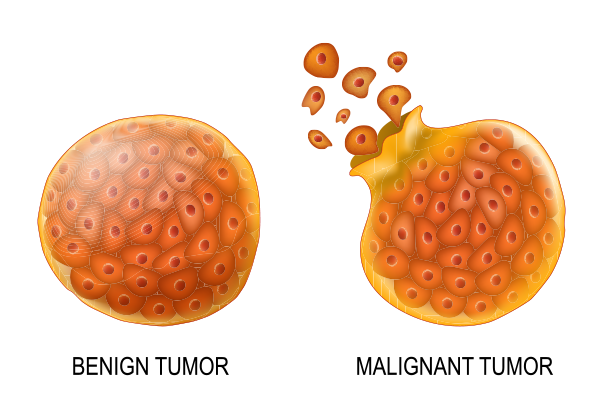
Brain tumours are abnormal growths of cells within or near the brain. They can be classified as either benign (noncancerous) or malignant (cancerous), each with distinct characteristics, treatment approaches, and prognoses. Understanding these differences is crucial for patients and caregivers navigating a brain tumours diagnosis. This blog is a compilation of all the information related to Benign and Malignant brain tumours, continue reading till the end to gather information on all these aspects.
What Is a Brain Tumour?
A brain tumour is an accumulation of abnormal cells in or near the brain, forming either primary tumours (originating in the brain) or secondary tumours (spreading from other parts of the body). Brain tumours can be benign or malignant. Symptoms depend on the tumours's size, type, and location and can range from seizures and headaches to cognitive and motor function disruption. The causes of primary brain tumours are mostly unknown, but risk factors include genetic conditions. Diagnosis involves physical exams, neurological tests, imaging, and biopsies. Treatment options include surgery, radiation therapy, and chemotherapy, with outcomes varying based on factors like tumours type and patient age. Early and accurate diagnosis is crucial for effective treatment and preventing brain damage.

Benign Brain tumours
Benign brain tumours are noncancerous growths that arise when cells divide more rapidly than usual or fail to be adequately eliminated by the body. These tumours typically grow slowly and stay localised, posing less of a threat compared to malignant tumours, which can spread and cause severe health issues. Although benign tumours often do not cause symptoms and may not require treatment, some can grow significantly large, leading to complications by compressing nearby structures. Common types of benign tumours include adenomas, fibromas, hemangiomas, lipomas, lymphangiomas, meningiomas, neuromas, and osteochondromas. Diagnosis involves medical evaluations and tests to distinguish between benign and malignant tumours. Treatment may include monitoring or surgical removal, especially if the tumours cause symptoms or have the potential to become malignant.
Malignant Brain Tumours
Malignant (cancerous) brain tumours originate from cancer cells. They often grow rapidly and can crowd the surrounding tissue. Malignant brain tumours can extend "roots" that invade surrounding tissue and healthy brain tissue. They can also remain contained (encapsulated). When malignant brain tumours develop or extend to areas of the brain that control important bodily functions, they can interfere with normal behaviour and become life-threatening. These aggressive tumours can become dangerous quickly.
| Feature | Benign tumours | Malignant tumours |
| Growth Rate | Slow | Invade and destroy the surrounding tissues |
| Invasion | Do not invade nearby tissues | Invade and destroy the surrounding tissues |
| Metastasis | Do not spread to other parts of the body | Rarely spread beyond the brain |
| Recurrence | Less likely after removal | More likely, even after treatment |
| Treatment Approach | Often surgical removal | Combination of surgery, radiation, and chemotherapy |
| Prognosis | Generally favorable |
Variable; depends on type and stage |
Diagnosing a brain tumour involves imaging tests like MRI or CT scans to detect abnormalities. A biopsy may be performed to determine the tumour's type. Treatment varies based on the tumour's type, size, and location. Options include surgery, radiation therapy, chemotherapy, and targeted therapy. Early and accurate diagnosis is crucial for effective treatment and preventing brain damage.
Conclusion
Understanding the distinction between benign and malignant brain tumours is essential for effective management and treatment. While benign tumours are generally less aggressive, they can still pose significant health risks depending on their size and location. Malignant tumours require prompt and often aggressive treatment due to their rapid growth and potential to invade surrounding brain tissue. Early detection and a comprehensive treatment plan tailored to the individual's specific condition are crucial for the best possible outcome. Contact our Manipal Hospital Team in Delhi to get expert Neurosurgeon advice.
FAQ's
Benign brain tumours are non-cancerous, typically grow slowly, and do not spread to other parts of the brain. Malignant brain tumours are cancerous, tend to grow rapidly, and can invade surrounding brain tissue.
While benign tumours are generally less aggressive, their location can still cause significant health issues by pressing on vital brain areas. Malignant tumours are more dangerous due to their rapid growth and potential to spread.
Symptoms can include persistent headaches, seizures, vision or hearing changes, balance issues, and cognitive or personality changes. The specific symptoms often depend on the tumour's location and size.
Diagnosis typically involves neurological examinations, imaging tests like MRI or CT scans, and sometimes a biopsy to determine the tumour type.
Treatment varies based on the tumour's type, size, and location. Options include surgery, radiation therapy, chemotherapy, and targeted drug therapy.
Benign tumours can often be completely removed surgically, leading to a cure. Malignant tumours may require a combination of treatments and have variable outcomes. Early detection and treatment improve the chances of a favourable prognosis.
While the exact causes of brain tumors are often unknown, certain factors like exposure to ionizing radiation and genetic conditions may increase risk. Maintaining a healthy lifestyle is beneficial for overall well-being.
Follow-up schedules depend on the tumor type and treatment received. Regular monitoring through physical examinations and imaging tests is crucial to detect any recurrence early.





















 5 Min Read
5 Min Read








_Early_Detection.png)






